Complete Solutions to EXERCISE of chapter Work, Energy and power of Class 11 book with complete answers and questions
| Class 11 | PHYSICS |
| Chapter | Work, Energy and power |
| SL ARORA | EXERCISE |
| Number Of Questions | 100 |
| Academic Year | 2023-24 |
What is the work done is crrrying a suitcase wighting 10 kg f on his head when he travels a distance of 5 m in the (i) verticl direction and (ii) horizontal direction ? `Take g=9.8 ms^(-2)`
View SolutionWhat is the work done is crrrying a suitcase wighting 10 kg f on his head when he travels a distance of 5 m in the (i) verticl direction and (ii) horizontal direction ? `Take g=9.8 ms^(-2)`
View SolutionCalculate the amount of work done by a labourer who carries n bricks, each of mass m, to the roof of a house of height h by climbing up a ladder.
View SolutionA man moves on a straight horizontal road with a block of mass 2 kg in his hand. If he covers a distance of 340 m with an acceleration of `0.5 m/s^2` find the work done by the man on the block during the motion.
View SolutionA force `F = (2hati-6 hatj) N` is applied on a body. which is sliding over a floor. If the body is displaced through `(-3 j )m`, how much work is done by the force?
View SolutionA force `vecF=hat i+5 hat j+7 hat k` acts on a particle and displaces it throught `vec s=6 hat I +9 hat k`. Calculate the work done if the force is in newton and displacement in metre.
(ii) Find the work done by force `vec F=2hat i-3 hat j+hatk` when its point of application moves from the point A(1,2,-3) to the point B (2,0, -5).
View SolutionA particle is acted upon by constant forces `vecF=-2hati+3hatj+4hatk and vecF_(2)=- hati+2hatj-3hatk` is distanced from the point A (2,1,0,) to the point B(-3,-4,2) Find the work done by forces.
View SolutionA man weighing 50kg f supports a body of 25 kg f on his head. What is the work done when he moves a distance of 20 m up an incline of 1 in 10? Take `g=9.8ms^(-2)`.
View SolutionExplain how work done by a variable force may be measured.
View SolutionA force F=(15+0.50x) acts on a particle in the X-directation ,where F is in newton and x in metre Find the work done ' by this force during a displacecment from x=0 to x=2.0 m .
View SolutionA force F=a+b x acts on a particle in the X-direction, where a and b are constants. Find the work done by this force during a displacement from x=0 to x=d/
View SolutionThe relation between the displacement x and the time t for a body of mass 2 kg moving under the action of a force is geven by `x=t^(3)//3` , where x is in metre and t in second ,Calculate the ork done by the body in first 2 seconds.
View Solution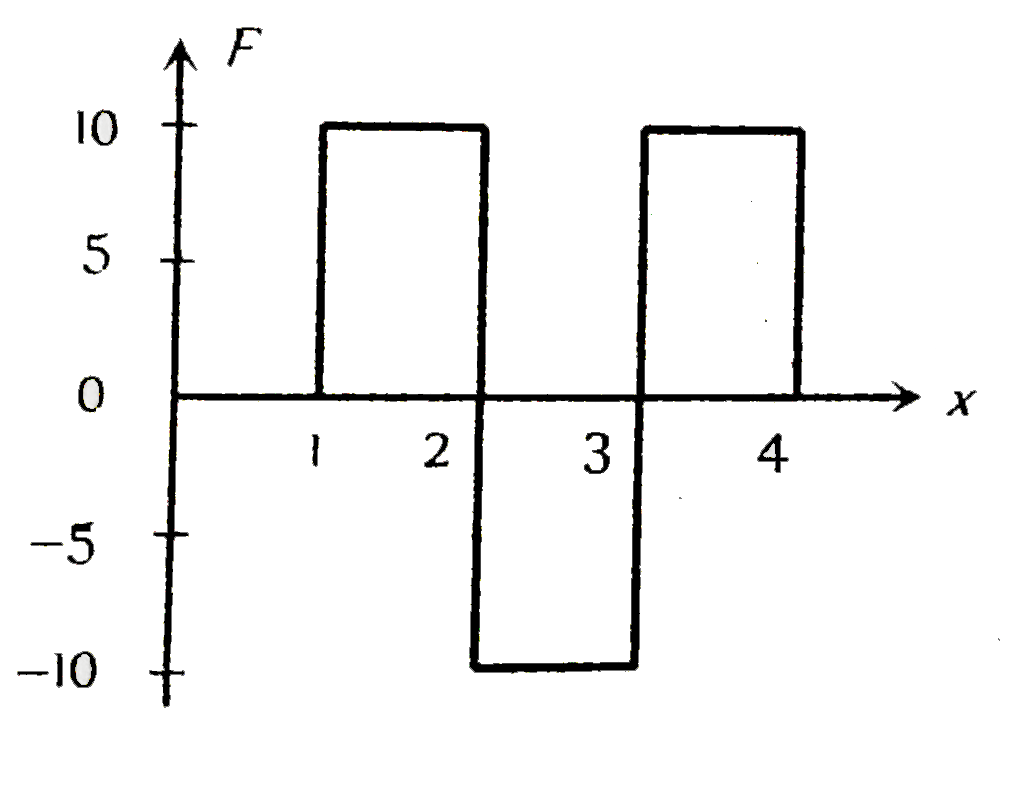
Figrue shows the F-x graph. Where F is the force applied x is the distance covered by the body along a straight line path. Given that F is in newton and x in metre, what is the work done?
View SolutionCalculate work done in moving the object from `x=2` to `x=3m ` from the graph shown here.
View SolutionThe momentum of a body of masss of 5kg is `500kg ms^(-1)`. Find the its K.E.
View SolutionA bullet of mass 20g is found is found to pass two points 30cm apart in a time interval of 4s. Calculate the kinetic energy of the bullet if it moves with constant speed.
View SolutionA body of mass `2kg` is resting on rough horizontal surface. A force `20N` is applied to it for `10s` parallel to the surface. If coefficient of kinetic friction between the surfaces in contact in `0.2.` Caluculate (i) work done by applied force in `10s`. (ii) change in `KE` of object in `10s`.
Take `g=10m//s^(2)`
View SolutionA body of mass 2kg is resting on a rough horizontal surface. A force of 20N is now applied to it for 10s, parallel to the surface. If the coefficient of kinetic friction between the surfaces of contact is 0.2. Calculate
change in kinetic energy of the object in 10s. (Take `g=10ms^(-2)`).
View SolutionA electron and a proton are detected in a cosmic ray experiment, the electron with K.E. of 5eV and the proton with K.E. of 50ev. Find the ratio of their speeds.
Given `m_(e)=911xx10^(31)kg and m_(p)-1.67xx10^(27)kg `
View SolutionA neutron of mass `1.66xx10^(-27)kg` is moving with a speed of `7xx10^(5)ms^(-1)`. Calculate late its kinetic energy .
View SolutionA neutron of mass `1.66xx10^(-27)kg` is moving with a speed of `7xx10^(5)ms^(-1)`. Calculate late its kinetic energy .
View SolutionA body of masss 1kg is allowed to fall freely under gravity. Find kinetic energy of the body 5 second after it starts falling. Take g=`10 ms^(-2)`
View SolutionTwo bodies of masses 1g and 16g are moving with equal kinetic energies. Find the ratio of the magnitudes of their linear momenta.
View SolutionIf the momentum of a body is increased by 50%, then what will be the perentage increase in the kinetic energey of the body?
View SolutionThe kinetic energy of a body decreases by 20%. What is the percentage decreases in its linear momentum?
View SolutionA running man has half the KE that a body of half his mass has. The man speeds up by `1.0ms^(-1)` and then has the same energy as the boy. What were the original speeds of the man and the boy?
View SolutionWhile catching a cricket ball of mass `200g` moving with a velocity of `20ms^(-1)`, the player draws his hands backwards through `20cm`. Find the work done in catching the ball and the average force exerted by the ball on the hand.
View SolutionA stone of mass 0.4kg is thrown vertically up with a speed of `9.8ms^(-1)`. Find the potential and kinetic energies after half second.
View SolutionA ball is throuwn vertially up with a velcity of `20ms^(-1)`. At height , will its K.E. be half its orginal value?
View Solution230 joules were spent in lifing a 10 kg weight to a height of 2 m. Calculate the acceleration with which it was raised? Take `g=10ms^(-2)`
View SolutionCalculate the work done in lifting a 300 N weight to a height of 10 m with an acceleration `0.5 ms^(-2)`. Take `g=10ms^(-2)`
View SolutionA bullet of mass 10 g travels horizontally with speed of `100 ms^(-1)` and is absorbed by a wooden block of mass 990 g suspended by a string. Find the vertical height through which the block rises. Take `g=10ms^(-2)`
View SolutionA simple pendulum of length `1m` has a wooden bob of mass `1kg`. It is struck by a bullet of mass `10g` moving with a speed of `200m//s`. The bullet gets embedded into the bob. Obtain the height to which the bob rises before swinging back.
Take `g=10m//s^(2)`.
View SolutionA spring gun has a spring constant of `80Ncm^(-1)`. The spring is compressed `12cm` by a ball of mass `15g`. How much is the potential energy of the spring ? If the trigger is pulled, what will be the velocity of ball ?
View SolutionA solid of mass 2 kg moving with a velocity of `10ms^(-1)` strikes an ideal weightless spring and produces a compression of 25 cm in it. Calculate the force constant of the spring.
View SolutionA 16kg block moving on a frictionless horiozntal surface with a velocity of `5cm^(-1)` compreses an ideal spering and comes to rest. If the force constant of the spring be `100Nms^(-1)`, then how much is the spring compressed?
View SolutionA block of mass `2kg` is propped from a heught of `40cm` on a spring where force constant is `1960Nm^(-1)` The maximum distance thought which the spring compressed by
View SolutionA block of massm, initally at rest is dropped from a height h onto a spring whose force constant is K. Find the maximum distance x through which the spring will be compressed.
View SolutionAn object is attached to a vertical springs and lowered slowly to its equilibrium position. This stretches the spring by a distance `d`. If the same object is attached to the same vertical spring, but permitted to fall freely, through what distance does it stretch the spring ?
View SolutionA massless platform is kept on a light elastic spring as shown in figure. When a small stone of mass 0.1 kg is dropped on the pan from a height of 0.24 m, the spring compresses by 0.01m. From what height should the stone be droppped to cause a compression of 0.04m in the spring ?
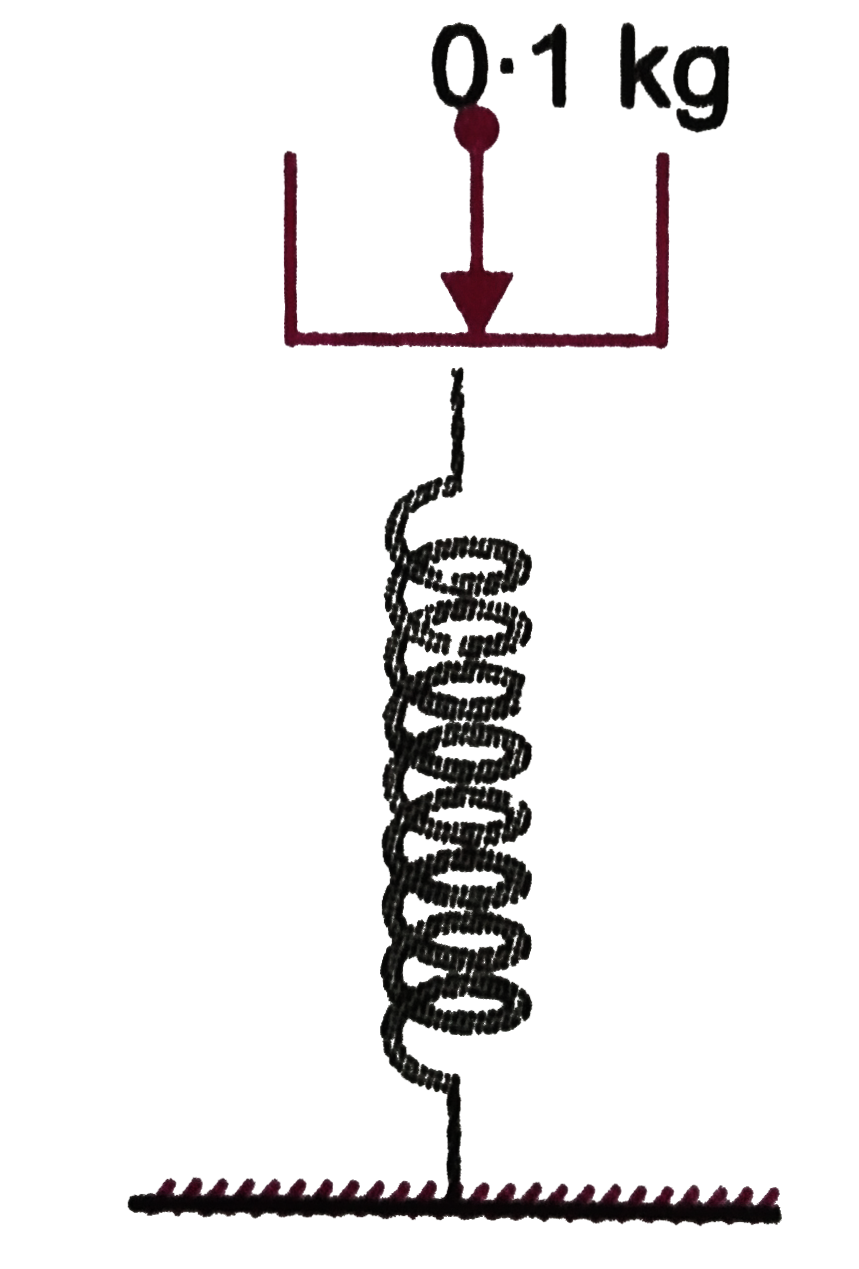
View SolutionAbout `4xx10^(9)kg` of matter is converted into energy in the sun each second. What is the power output of the sun ?
View SolutionShow that energy equivalent to atomic mass unit equals nearly 933 MeV of energy. Given 1 automic mass unit = `1.66xx10^(-27)kg`
View Solution500 kg of water is heated from `20^(@)` to `100^(@)` C . Calculate the increase in the mass of water.Given specific heat of water `=4.2 xx 10^(3) J kg ^(-1) .^(@)C^(-1)`.
View Solution1 mg of uranium is completely destroyed in an atomic bomb. How much energy is liberated ?
View SolutionAn electron - positron pair annihilates at rest to produce `gamma`-rays. Calculate the energy produced in MeV if the rest mass of electron is `9.1xx10^(-31)kg`.
View Solutionif 10 g of mass is completely converted into energy, then find the corresponding energy produced.
View SolutionA lift is designed to carry a load of 4000kg through 10 floors of a building averaging 6m per floor in 10seconds. Calculate the forse power of the lift.
View SolutionA machine can take out 1000 kg of mud hour from a dept of 100 m . If efficieny of the machine is 0.9 , calculate its power.
View SolutionOne coolie takes 1min to raise a box through a height of `2m`. Another one takes `30s` for the same job and does the same amount of work. Which one of the two has greater power and which one uses greater enegy?
View SolutionAn energies of 4.9 K.W power is used to pump water from a well 50 m deep. Calculate the quantity of water in kilo which it can pump out in one hour.
View SolutionWater is pumped out of a well 10 m deep by mean of a pump rated at 10 kW . Find the efficient of the motor if 4200 kg of water is pumped out every minutes . Take `g=10 ms ^(-2)`.
View SolutionA `30m` deep well is having water up to `15 m`. An engine evacuates it in one hour . The power of the engine. If the diameter of the well is `4m` is
View SolutionThe human heart forces `4000cm^(3)` of blood per minute through the arteries under pressure of `130mm` . The density of blood is `1.03g//c c`. What is the horse power of the heart ?
View SolutionA car of mass 1000kg accelerates uniformly from rest to a velocity of `54km//h` in 5 seconds. Calculate (i) its acceleration (ii) its gain in KE (iii) average power of the engine during this period.
View SolutionA car of mass 1000kg accelerates uniformly from rest to a velocity of `54km//h` in 5 seconds. Calculate (i) its acceleration (ii) its gain in KE (iii) average power of the engine during this period.
View SolutionA car of mass 1000 kg accelerrates uniformly from rest to a velocity of `54km h^(-1)` in 5 seconds. Calculate average power of the engine during this period, neglect friction.
View SolutionA vehicle of mass 30 quintals moving with a speed of `18km h^(-1)` collides with another vehicle of mass 90 quintals moving with a speed of `14.4 km h^(-1)` in the opposite direction. What will be the velocity of each after the collision?
View SolutionA body of mass 2 kg makes an elastic collision with another body at rest and contiues to move in the original direction with a speed equal to one thrid of its original speed. Find the mass of the second body.
View SolutionBall A of mass m strickes a stationary ball B of mass M and undergoes an elastic collision. After collision ball A has a speed one third of its initial speed. The ratio of M/m is
View SolutionTwo particles of masses 0.5 kg and 0.25kg moving with velocity 4.0 m`//`s and -3.0m`//` collide head on in a perfectly inelastic collision. Find the velocity of the composite particle after collision and KE lost in the collision.
View SolutionTwo particles of masses 0.5 kg and 0.25kg moving with velocity 4.0 m`//`s and -3.0m`//` collide head on in a perfectly inelastic collision. Find the velocity of the composite particle after collision and KE lost in the collision.
View SolutionWhat percentage of the K.E. of a moving particle is transferred to a stationary particle when it strikes the stationary particle four times its mass ?
View SolutionA neutron moving with a speed of `10^6 ms^(-1)` suffers a head - on collision with a nucleus of mass number 80. What is the fraction of energy retained by the neutron?
View SolutionWhat percentage of `K.E.` of a moving particle is transferred to a stationary particle, when moving particle strikes with a stationary particle of mass (a) 19 times in mass (b) equal in mass (c) `(1)/(19)` th of its mass ?
View SolutionWhat percentage of `K.E.` of a moving particle is transferred to a stationary particle, when moving particle strikes with a stationary particle of mass (a) 19 times in mass (b) equal in mass (c) `(1)/(19)` th of its mass ?
View SolutionWhat percentage of `K.E.` of a moving particle is transferred to a stationary particle, when moving particle strikes with a stationary particle of mass (a) 19 times in mass (b) equal in mass (c) `(1)/(19)` th of its mass ?
View SolutionA ball is dropped from a height of 3 m. What is the height upto which the ball will rebound ? The cofficient of restitution is 0.5.
View SolutionA ball is dropped from a height h on to a floor . If the cofficient of restitution is e, calculate the height the ball first rebounds ?
View SolutionA body moves a distance of 10 m under the action of force F=10N. If the work done is 25 J, the angle which the force makes with the direction of motion is
View SolutionA force `vecF=2hati-3hatj+7hatk(N)` acts on a particle which undergoes a displacement `vecr=7hati+3hatj-2hatk`
(M). Calculate the work done by the force
View SolutionA force `(vecF) = 3 hati + c hatj + 2 hatk` acting on a partical causes a displacement: `(vecs) = - 4 hati + 2 hatj + 3 hatk` in its own direction . If the work done is `6 j`, then the value of `c` is
View SolutionWhen a body moves with a constant speed along a circle
View SolutionA ball moves on a frictionless inclined table without slipping. The work done by the surface on the ball is :
View SolutionA body of mass 2 kg is placed on rough horizontal plane. The coefficient of friction between body and plane is 0.2 Then,

View Solution`oversetrightarrowF.oversetrightarrowds`?
View SolutionA particale moves under the effect of a force `F = Cs` from `x = 0` to `x = x_(1)`. The work down in the process is
View SolutionA force `F=(10+0.5 x)` acts on a particle in the x-direction. What would be the work done by this force during a displacement from `x=0` to `x=2m` (F is in newton and x in metre)
View SolutionThe work done by an applied variable force `F=x+x^(3)` from x = 0 m to x = 2m, where x is displacement, is
View SolutionThe relationship between the force F and position x of body is as shown in figure. The work done in displacing the body in displacing the body from (`x = 1 m` to `x = 5 m`) will be
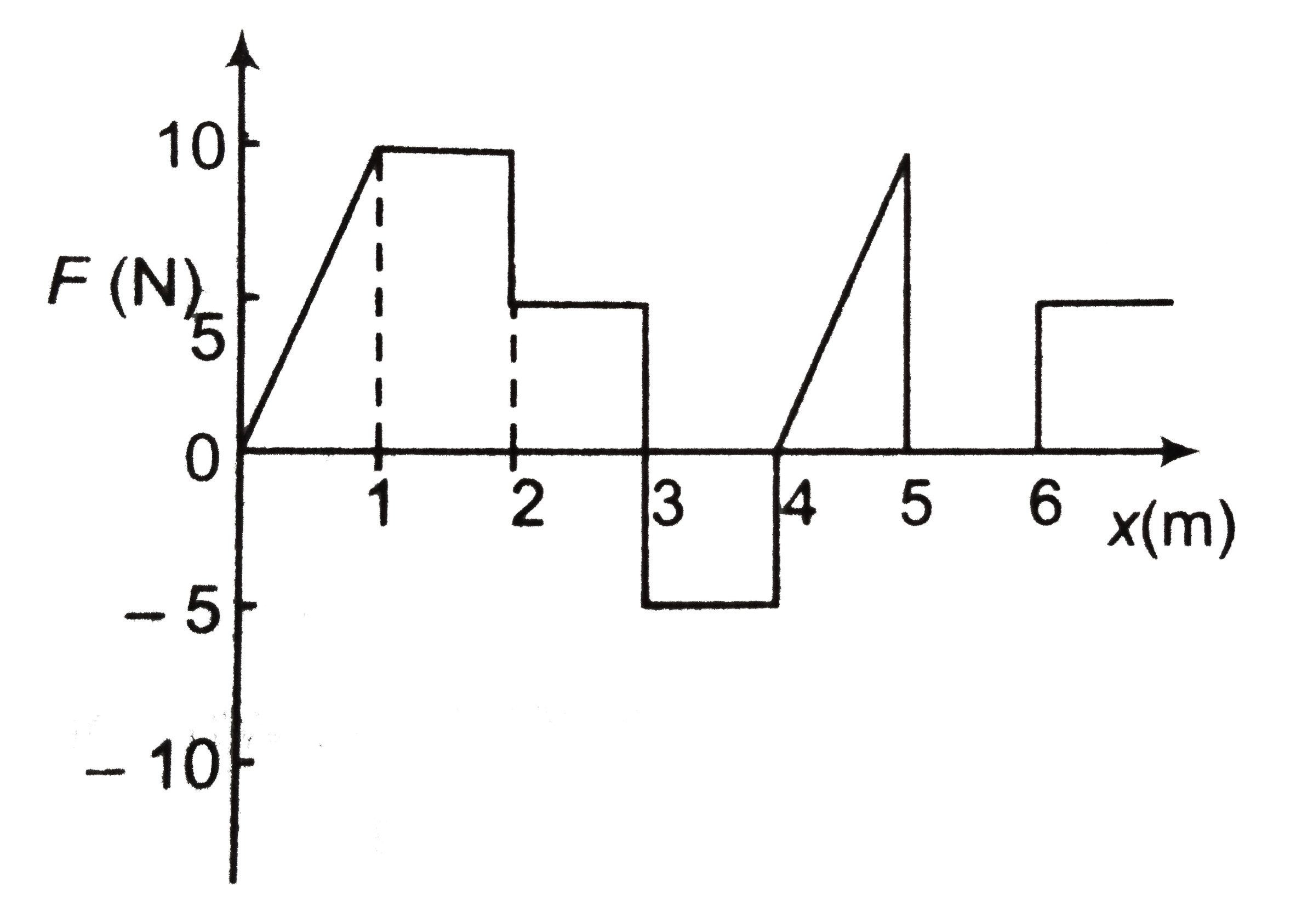 .
.
View SolutionThe kinetic energy of a body of mass 2 kg and momentum of 2 Ns is
View SolutionTwo bodies of masses m and 4 m are moving with equal K.E. The ratio of their linear momentums is
View SolutionTwo bodies A and B having mass m and M respectively ppossess same kinetic energy. Given that M>m. If `p_A` and `p_B` be their moments, then which of the following statements is true?
View SolutionIf momentum is increased by `20%` then K.E. increases by
View SolutionIf momentum is increased by 20% , then K.E. increase by
View SolutionA body of mass 10 kg initially at rest acquires velocity `10 ms^(-1)`. What is the work done ?
View SolutionHow much work must work be done by a force on 50 kg body in order to accelerate it in the direction of force from rest to `20 ms^(-1)` is 10 s?
View SolutionA taxi without any passengers, moving on a frictionless horizontal road, with a velocity u can be stopped in a distance d. Now the passengers and 40% to its weight. What is the stopping distance at veolcity u, if the retardation remains the same?
View SolutionIf the potential energy between two molecules is given by `U= -(A)/(r^6) + B/(r^(12))` , then at equilibrium , separation between molecules , and the potential energy are :
View SolutionThe potential energy of a particle of mass 5 kg moving in the `x-y` plane is given by `U=(-7x+24y)J`, where x and y are given in metre. If the particle starts from rest, from the origin, then the speed of the particle at `t=2`s is
View SolutionA simple pendulum hanging freely and at rest is vertical because in that position
View SolutionA pendulum of length 2 m lift at P . When it reaches Q , it losses 10% of its total energy due to air resistance. The velocity at Q is
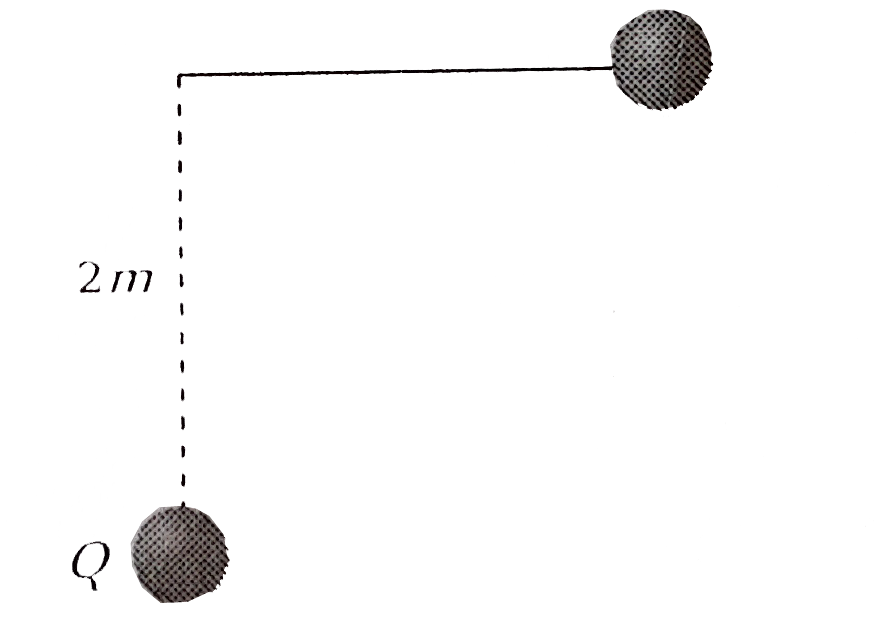
View SolutionA pendulum bob on a 2 m string is displaced `60^(@)` from the vertical and then released. What is the speed of the bob as it passes through the lowest point in its path
View Solution300J of work is done in slinding a 2 kg block up an inclined plane of height 10m. Taking g =`10m//s^(2)` , work done against friction is
View SolutionA body, thrown upward with some velocity reaches the maximum height of `50 m`. Another body with double the mass thrown up with double the initial velocity will reach a maximum height of
View SolutionA uniform rope of total length l is at rest on a table with fraction f of its length hanging (see figure). If the coefficient of friction between the table and the chain is `mu` then
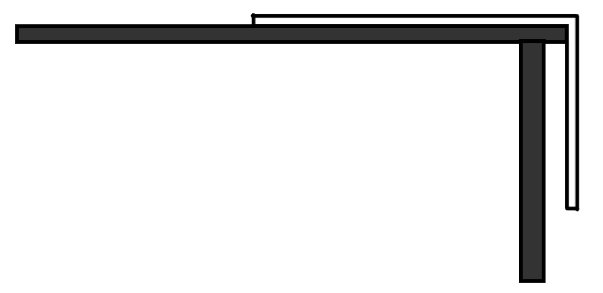
View SolutionThe dimensions of `K` in the equation `W=1/2Kx^(2)` is
View SolutionThe work done by the external agent in stretching a spring of force constant `k` from length `l_(1)`to `l_(2)` is
View SolutionA spring of force constant `800N//m` has an extension of 5cm. The work done in extending it from 5cm to 15cm is
View SolutionTwo springs of spring constants `1500N//m` and `3000N//m` respectively are streched by the same force. The potential energy gained by the two springs will be in the ratio
View SolutionWhen a spring is stretched by 2 cm, it stores 100 J of energy. If it is further stretched by 2 cm, the stored energy will be increased by
View Solution
EXERCISE questions and complete solutions for chapter Work, Energy and power of DHANPAT RAI & CO PHYSICS (HINGLISH) of Class 11